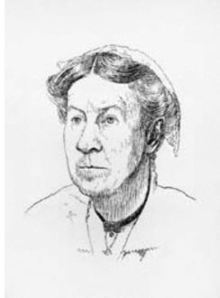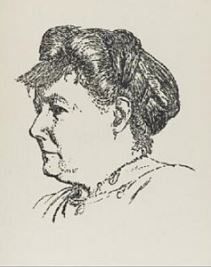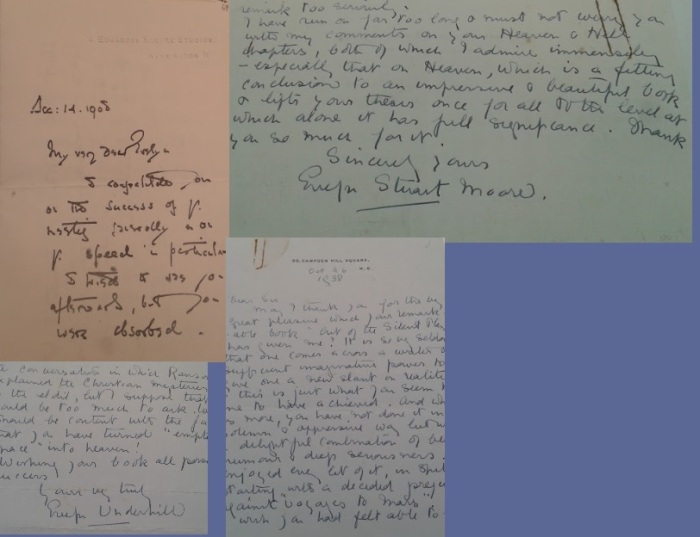
Evelyn Underhill, May Sinclair and Adventures in Practical Mysticism
By Alice Theobald
Just as May Sinclair is too often restricted to the footnotes of critical guides to modernism, so too has the influence of Evelyn Underhill (1875-1941) been unjustly eclipsed. Within their lifetimes both women achieved great public acclaim, securing national and transatlantic success. In their literary and intellectual feats, Sinclair and Underhill were at the forefront of twentieth century developments in psychology, philosophy and the growth of the ‘New Woman’ in the public sphere.
1922 is commonly cited as the modernist annus mirabilis with the publication of James Joyce’s Ulysses and T.S. Eliot’s The Waste Land. Yet 1922 was also a kind of annus mirabilis for Sinclair herself with the release of Life and Death of Harriet Frean, Anne Severn and the Fieldings, and her philosophical treatise, The New Idealism. Underhill’s success, too, was built upon that year with The Life of the Spirit and the Life of Today. Beyond the commercial success these publications represent, the intersection between philosophy, psychology and mysticism demonstrates the plurality of interests underpinning their work. An exploration of Sinclair’s and Underhill’s friendship, moreover, casts valuable light on Sinclair’s fiction and the milieu in which it flourished – a cultural climate in which she was lauded, in 1920, as ‘the most widely known woman artist in the country and America’ (Thomas Moult, September 1920, quoted in Boll, 1973: 16).

Despite such accolades and her public success, Sinclair’s acute shyness does not lend itself to placing her at the centre of any critical study of the period. Nor does the intellectual rigour of her work immediately invite new readers (in Mary Olivier, for example, Mary’s philosophical and intellectual encounters are just as formative as her personal ones). Similarly, Underhill wrote over 350 articles and reviews which are now mostly out of print and unobtainable. A number of these were produced during her prestigious three-year post as theological editor for The Spectator from 1929 (around the same time Sinclair left London, as her health declined). The grounding of Sinclair’s and Underhill’s oeuvres in epistemology and debates around idealism, vitalism and mysticism can seem excessively recondite. Yet this is precisely the opposite of their intentions. Underhill’s Practical Mysticism: A Little Book for Normal People (1914) asserted in its Preface: ‘The spiritual life is not a special career, involving abstraction from the world of being’. Her early work, Mysticism – which has never been out of print since its publication in 1911 (Beeson, 2011: 142) – likewise affirmed that ‘[t]o be a mystic is simply to participate here and now in that real and eternal life […] – in the joyous travail of the Universe’ (447). In their fiction and non-fiction, both writers explored how to realise that heightened participation in the ‘here and now’.

Discussing Sinclair’s and Underhill’s relationship, Suzanne Raitt observes that ‘the two women formed a close friendship partly based around their mutual love of yachting’ and that ‘their relationship revolved around the active, rather than the contemplative, life’ (2000: 235-236). Beyond their shared hobbies, however, theirs was an intellectual acquaintance, played out in letters praising and critiquing each other’s work. In a 1911 letter sent from her home in Campden Hill Square, Underhill described to Sinclair the ‘delicious business of criticising what one is wholly incapable of creating oneself’, affirming ‘how enormously’ she admired her work, wishing ‘[m]uch love & many congratulations’ (2010: 191). Indeed in the early part of the twentieth century, Sinclair and Underhill lived a mere mile apart, at either end of Holland Park. In 1913, Sinclair is also thought to have met poet Charlotte Mew at a gathering at Underhill’s house, while the two also frequently dined together with members of the Imagist circle (Collecott, 1999: 164). They shared a profoundly intellectual and even spiritual affinity, engaging with external debate and cultural trends. Having received a copy of The Combined Maze (1913), Underhill wrote: ‘wonderful triumph, – the way in which you have made all the little incidents and the whole life in that ordinary little house seem so supremely important and absorbing’ (quoted in Boll, 1973: 103). Recurrently, Sinclair and Underhill cherish – and elevate – what constitutes the ‘ordinary’. Cultivating ‘little incidents’ and moments pointing towards a larger personal or cosmic significance, they ‘plunge’ into quotidian ‘reality’ (just as Sinclair wrote of Dorothy Richardson, The Egoist, April 1918: 57) and, by virtue of this, they feel they can access higher states of consciousness and numinous life-forces.
In 1917, the publication of A Defence of Idealism resulted in Sinclair’s election to the Aristotelian Society. The book was dedicated to Underhill, ‘to whose work in this field’ Sinclair professed herself ‘more indebted than [she] can say’ (1917: xvii). This indebtedness was perhaps most prominently manifested in Sinclair’s treatment of the ‘here and now’ nature of Reality. From the outset, Underhill had affirmed in Mysticism (1911) that ‘[t]o be a mystic is simply to participate here and now in that real and eternal life’ (447). Having critiqued the work of contemporary thinkers such as William James and Bertrand Russell, Sinclair likewise concluded A Defence with a consideration of ‘Reality here and now’ (338). At this point, her philosophical treatise subtly shifts to a more direct, even hortative, mode in which we are compelled to foster that ‘Reality’. The appraisal thus assumes an immediacy and implicitly personal imperative. We are directed, at last, to realise that ‘Reality’ for ourselves. It is only in such ‘moments’ that ‘things we have seen all our lives […] change to us in an instant of time, and show the secret and imperishable life they harbour’ (339).
In the same vein, Underhill’s mode of practical mysticism distanced itself from any philosophical abstraction; instead, it was rooted in everyday life: ‘[t]his amount of mystical perception – this “ordinary contemplation,” as the specialists call it – is possible to all’ (Practical Mysticism: 8). Underhill did not address ‘the specialists’. Instead, she urged that her readers approach the godhead in even apparently ‘ordinary’ circumstances. Underhill’s earliest novel, The Grey World (1904) thus asserted towards its conclusion: ‘It’s only when you’ve entered into loving alliance with the Universe that you are making the most of life’ (1904: 307). Across their appraisals of philosophy, mysticism and indeed modernist narrative methods, Sinclair and Underhill place a premium upon an immediacy: ‘making the most of life’. Sinclair’s reviews of H.D. and Dorothy Richardson (despite the formal differences in their verse against prose modes) privilege their works’ stark, striking intensity: as in Richardson’s using her ‘senses so purely and with so intense a joy’ (The Egoist, April 1918: 58) and H.D’s ‘depth and intensity of vision’ (‘The Poems of H.D., The Dial, Vol. 72, February 1922, 203-207: 209). The task of practical mysticism, moreover, was to develop that invigorating intensity. Sinclair’s appraisal of the Imagists thus applies equally to practical mysticism: ‘What the Imagists are “out for” is direct naked contact with reality. You must get closer and closer’ (The Egoist, June 1st 1915, ‘Two Notes: On Imagism’: 88). The ‘plunge’ into reality, in other words, reaps inward invigoration as well as elevation: it grants a simultaneously deeper and higher vision. Indeed practical mystics ‘do not withdraw from the stream of natural life and effort, but plunge into it more deeply, seek its heart’ (Underhill, The Life of the Spirit and the Life of Today: 42). In each case, it is an intensity of vision and an exulted yet self-substantiating reality that is sought. Underhill again writes, in Mysticism, that ‘Mysticism, like revelation, is final and personal. It is not merely a beautiful and suggestive diagram of experience, but is of the very stuff of life’ (98). It thus entails both a self-discovery and a loss of contained selfhood in higher communion with the divine. In Sinclair’s Künstlerroman, Mary Olivier (1919), however, the narrative privileges that ‘personal’ aspect of ‘revelation’ as an ultimately inward-validating state.
If 1922 is held as the annus mirabilis in a modernist canon typically excluding Sinclair and Underhill, their writing cultivates its own self-renewing momentum mirabile of sorts – encompassing both poised moments and movement towards a higher Reality. Sinclair thus concluded her Defence of Idealism by cherishing the ‘heightening of psychic intensity’ by which we ‘discern Reality here and now’:
No reasoning allows or accounts for these moments. But lovers and poets and painters and musicians and mystics and heroes know them: moments when eternal Beauty is seized travelling through time; […] Reality gives itself to our very sight and touch (1917: 339).
In Sinclair’s fiction, those moments of ‘truly seeing’ reality are manifested in terms of self-illumination. The search for a ‘Reality’ that ‘gives itself to our very sight and touch’ is translated to a personal quest for self-discovery. Indeed in 1922 T. S. Eliot himself credited Sinclair with pioneering a ‘new’ form of fiction altogether – ‘the psychoanalytic type’ (‘London Letter’, The Dial, September 1922). Nurturing individual interiority, the tentative sense of self-belonging Mary Olivier eventually achieves is figured as a union with a secret, private self: ‘her real, secret life’ (314) and her ‘real, secret self’ (305). Secrecy and happiness, accordingly, are frequently collocated: ‘a secret, happy smile’ (335); ‘her secret happiness’ (93, 94, 226, 335). It is not just that Mary has distanced herself from stifling familial relations and external codes, but that she taps into a mode of practical mysticism – attaining both a higher reality and a deeper self-possession.
To be a practical mystic, then, is to be at once immersed in and above the ‘ordinary’: it is to navigate the ebb and flow of existence, or ‘all the ecstasy, all the anguish that we extract from the rhythm of life and death’ (The Life of the Spirit and the Life of Today: 28). Yet within such fluctuation, an animated and stable selfhood can be discovered. When she comes to realise a tacitly liberated identity, Mary’s feeing is described with visual, deictic immediacy ‘streaming in and out of her till its ebb and flow were the rhythm of her life’ (377). Through her practical, personal mode of mysticism, Mary Olivier navigates not just ‘the rhythm of life and death’ described by Underhill but one that is her own – aligned with the ‘rhythm of her life’ and a sense that ‘[k]nowing reality’ amounts to embracing a ‘real self’.
Underhill herself noted the mystic’s ‘secret of his own deeper life’ that emerges alongside the ‘secret of union with Reality’ and the ‘Divine Secret’. To be a practical mystic is to unite that depth of self, immanent ‘Reality’, and a transcendental ‘Divine Secret’. Yet for all its celestial elevation, the mode remains ‘a condition of humble access, a life-movement of the self’ (Mysticism: 85). It is both a movement towards the divine and, perhaps more crucially, a centralising ‘life-movement of the self’. In line with this, the ultimate ‘secret’ Mary Olivier discovers is her own self-belonging:
For twenty-three years something had come between her and reality. She could see what it was now. She had gone through life wanting things, wanting people, clinging to the thought of them, not able to keep off them and let them go (378).
Rather than ‘clinging’ to self-relegating relations and conventions, Mary is able in adulthood to discover a more assured sense of self. Her poetry, too, is part of this drive for self-ownership: ‘She would make poems. They couldn’t hear you making poems. They couldn’t see your thoughts falling into sound patterns’ (184).
Clive Bell, in his 1914 book, Art, also drew a parallel between mysticism and the creative impulse: ‘For the mystic, as for the artist, the physical universe is a means to ecstasy […]. He seeks within all things that ultimate reality which provokes emotional exaltation’ (1931: 81-82). For Mary Olivier, however, that ‘ultimate reality’ is herself. It exists in discovering and preserving her ‘real, secret self’ (305). In its final fruition, this personal secret ‘didn’t hide’. Her internal self-possession safeguards a ‘secret’, stable point of ‘happiness’ despite life’s external ebb and flow:
She knew only one thing about perfect happiness: it didn’t hide […]. There were little happinesses, pleasures that came like that (378).
Despite external setbacks, Mary strives to maintain an inward uplift: ‘They had all gone, and yet she was happy’ (378). Amid her navigation of life’s flux, Mary’s tentative optimism is figured in tangible, immediate terms: ‘little happinesses, pleasures that came like that’. Equally underscoring a concentration on immediate, personally affective states, Underhill noted in Practical Mysticism that ‘the mystical consciousness has the power of lifting those who possess it to a plane of reality which no struggle, no cruelty, can disturb’ (1-2). Even more so than ‘lifting’ one above reality, to possess a ‘mystical consciousness’ becomes tantamount to possessing oneself – plunging into externality in order to substantiate an inward state. ‘[L]ifting those who possess it’ to a higher communion, it shores up a heightened inward consciousness and an intensity of vision to enliven intimate self-arrivals and expansive adventures in Reality.
Published March 2016.
Bibliography
Beeson, Trevor, The Church’s Other Half: Women’s Ministry (London: SCM Press, 2011)
Bell, Clive, Art (1914, reprinted London: Chatto and Windus, 1931)
Boll, Theophilus, Miss May Sinclair: Novelist (New Jersey: Associated University Presses, 1973)
Collecott, Diana, H.D. and Sapphic Modernism (Cambridge: Cambridge University Press, 1999)
Raitt, Suzanne, May Sinclair: A Modern Victorian (Oxford: Clarendon Press, 2000)
Sinclair, May, Mary Olivier: A Life (London: Macmillan, 1919)
Sinclair, May, A Defence of Idealism: Some Questions and Conclusions (London: Macmillan, 1917)
Underhill, Evelyn, The Making of a Mystic: New and Selected Letters, ed. by Carol Poston (Chicago: University of Illinois Press, 2010)
Underhill, Evelyn, The Life of the Spirit and the Life of Today (London: Methuen, 1922)
Underhill, Evelyn Practical Mysticism: A Little Book for Normal People (New York: E. P. Dutton, 1914)
Underhill, Evelyn, Mysticism: A Study of the Nature and Development of Man’s Spiritual Consciousness (London: Methuen, 1911)
Underhill, Evelyn, The Grey World (London: William Heinemann, 1904)